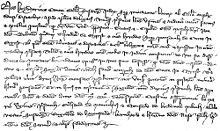Eschat log

The eschat protocol of this simple document from the year 1317 translates as follows: “As a testimony to this we believed that we had to attach our seal to this document. Done and given in 1317 on the day after the Assumption of Mary in the presence of the knights Everhard von Meiningsen and Erenfried von Bredenohl, Vicar Albert in Soest, Engelbert von Hegenscheid, the brothers Bernhard and Hermann Nase, Hermann Schreiber and other credible people. "
The final protocol of a classic medieval document is called eschatokoll (from the Greek eschaton , the uttermost, last) .
In the Middle Ages , most of the documents were tied to fixed forms to ensure credibility and to avoid forgery. This included the minutes written at the beginning , then the actual text and finally the eschat minutes .
It usually contains the following elements:
- Subscriptio , i.e. the signatures of the author and the witnesses present, a script formula and the benevalete
- In addition, the so-called Rota , a circular sign with the motto of the Pope in question, is part of the subscriptio in some Papal documents . The seal, the bull, is also part of the eschat protocol.
- This also includes the recognition line , the recognition mark of the notary / chancellor, in the case of German royal documents nominally the imperial orchancellor, the archbishop of Mainz. Notaries and judges use specially designed signs in the form of crosses and other monogrammatic forms, right through to heraldic elements.
- Rulers' deeds usually contained an apprecatio , a brief blessing
- The dating according to the year, usually as an indiction year , the ruler year and other specific office customs, with location and date.
literature
- Ahasver von Brandt : tool of the historian. An introduction to the historical auxiliary sciences . 13th edition. Kohlhammer, Berlin et al. 1992, ISBN 3-17-012099-9 , ( Urban Taschenbücher 33).
- Peter Rück : Photo reports from the king. Chancellor signs, royal monograms and the Salic Dynasty signet . Institute for Historical Auxiliary Sciences, Marburg an der Lahn 1996, ISBN 3-8185-0203-X , ( Elementa diplomatica 4).
Web links
- Escha records of papal documents ( Memento of May 6, 2011 in the Internet Archive )
- Definition from Historicum.net
- Elements of the eschat protocol at Subscriptio from the University of Bamberg